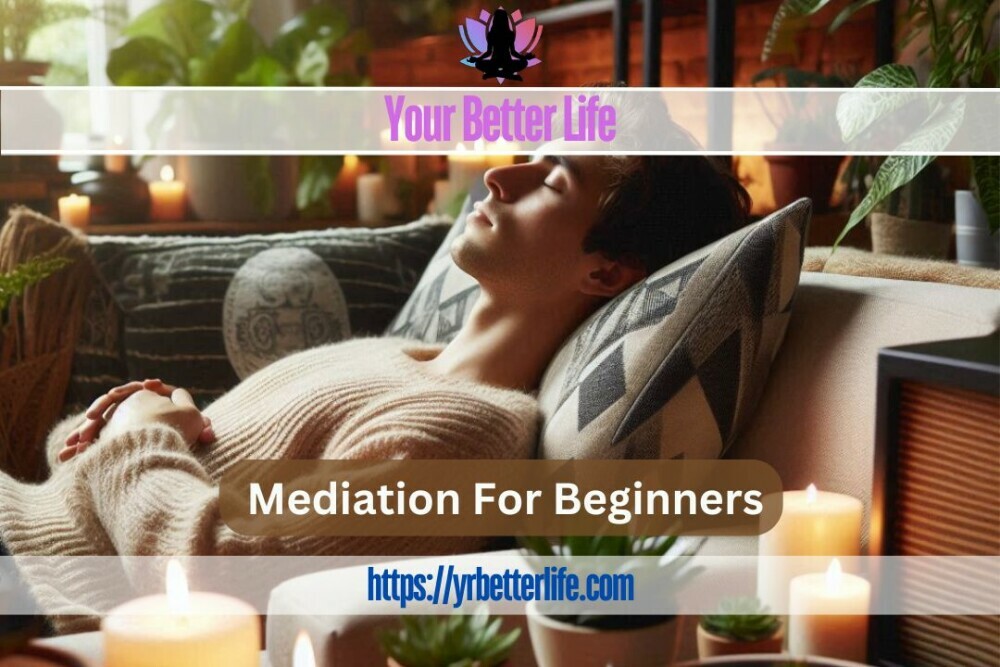
Meditation is a powerful practice that has been utilized for thousands of years to enhance mental clarity, emotional stability, and overall well-being. For beginners, diving into the world of meditation can seem daunting due to the plethora of techniques available. This comprehensive guide explores ten effective meditation techniques tailored for those new to the practice. Each method is designed to help you develop mindfulness, reduce stress, and cultivate a deeper sense of inner peace.
1. Mindfulness Meditation
Overview: Mindfulness meditation is about being fully present in the moment, acknowledging your thoughts and feelings without judgment. It’s one of the most popular forms of meditation, thanks to its simplicity and profound effects.
How to Practice:
- Find a Quiet Space: Sit comfortably in a chair or on the floor with your back straight.
- Focus on Your Breath: Close your eyes and concentrate on your breathing. Notice the sensation of air entering and leaving your nostrils.
- Acknowledge Thoughts: When your mind wanders, gently bring your focus back to your breath. Don’t judge your thoughts; simply acknowledge them and let them go.
- Duration: Start with 5-10 minutes daily, gradually increasing to 20-30 minutes.
Benefits:
- Reduces stress and anxiety
- Improves focus and concentration
- Enhances emotional regulation
2. Guided Meditation
Overview: Guided meditation involves listening to a trained meditation guide who leads you through a series of visualizations or instructions. This technique is particularly helpful for beginners as it provides structure and direction.
How to Practice:
- Choose a Guide: Select a guided meditation audio or video that appeals to you. Many apps and websites offer free resources.
- Comfortable Position: Sit or lie down in a comfortable position.
- Follow the Guide: Close your eyes and listen to the guide’s instructions, allowing yourself to be led through the meditation.
- Duration: Sessions typically range from 10 to 45 minutes.
Benefits:
- Eases beginners into meditation
- Provides a variety of themes and focuses, such as relaxation, healing, or mindfulness
- Enhances visualization skills
3. Loving-Kindness Meditation (Metta)
Overview: Loving-kindness meditation, or Metta, focuses on cultivating compassion and love towards oneself and others. It involves silently repeating phrases that express good wishes for oneself and others.
How to Practice:
- Comfortable Seat: Sit in a comfortable position with your eyes closed.
- Begin with Yourself: Silently repeat phrases like “May I be happy. May I be healthy. May I be safe. May I live with ease.”
- Extend to Others: Gradually extend these wishes to others—first to loved ones, then to acquaintances, and finally to those you find challenging.
- Duration: Practice for 10-20 minutes.
Benefits:
- Enhances compassion and empathy
- Reduces negative emotions and anger
- Fosters a sense of connection with others
4. Body Scan Meditation
Overview: Body scan meditation involves mentally scanning your body for areas of tension and bringing awareness to each part. This practice promotes relaxation and a deeper connection with your physical self.
How to Practice:
- Lie Down: Lie comfortably on your back with your arms at your sides.
- Focus on Breath: Take a few deep breaths to relax.
- Scan Your Body: Starting from your toes, gradually move your attention up your body. Notice any sensations or areas of tension.
- Acknowledge and Release: If you find tension, acknowledge it without judgment and try to release it.
- Duration: Spend 20-30 minutes on the entire body scan.
Benefits:
- Enhances body awareness
- Promotes deep relaxation and stress relief
- Helps identify and release physical tension
5. Transcendental Meditation (TM)
Overview: Transcendental Meditation is a form of silent mantra meditation. Practitioners silently repeat a specific mantra to transcend ordinary thought and experience a state of restful alertness.
How to Practice:
- Learn the Technique: TM requires instruction from a certified TM teacher who will provide you with a personal mantra.
- Sit Comfortably: Sit with your eyes closed and start silently repeating the mantra.
- Allow Thoughts: If thoughts arise, gently return to the mantra without judgment.
- Duration: Practice for 20 minutes twice a day.
Benefits:
- Deep relaxation
- Improved cognitive function and creativity
- Reduced anxiety and stress
6. Breathing Meditation
Overview: Breathing meditation centers around focusing on the breath, making it one of the simplest and most accessible forms of meditation for beginners. This practice helps in calming the mind and bringing you into the present moment.
How to Practice:
- Comfortable Position: Sit or lie down in a comfortable position.
- Focus on Breath: Close your eyes and concentrate on your breathing. Feel the rise and fall of your chest and abdomen.
- Deep Breaths: Take slow, deep breaths, inhaling through your nose and exhaling through your mouth.
- Counting Breaths: To enhance focus, you can count your breaths from 1 to 10 and then start over.
- Duration: Begin with 5-10 minutes, gradually increasing to 20 minutes.
Benefits:
- Reduces stress and anxiety
- Improves concentration and mental clarity
- Promotes a sense of calm and relaxation
7. Walking Meditation
Overview: Walking meditation involves being mindful while walking. It combines the benefits of physical activity with meditation, making it a good choice for those who find sitting still challenging.
How to Practice:
- Choose a Path: Find a quiet, safe place to walk, either indoors or outdoors.
- Walk Slowly: Walk slowly and deliberately, paying attention to the sensations in your feet and legs.
- Focus on Movement: Be mindful of each step, the movement of your body, and your surroundings.
- Breath Awareness: Coordinate your breathing with your steps for added focus.
- Duration: Practice for 10-30 minutes.
Benefits:
- Combines physical exercise with mindfulness
- Enhances awareness of the body and surroundings
- Reduces stress and improves mood
8. Mantra Meditation
Overview: Mantra meditation involves the repetition of a word, phrase, or sound to help focus the mind and achieve a deeper state of meditation. The mantra can be silently repeated or chanted aloud.
How to Practice:
- Choose a Mantra: Select a word or phrase that resonates with you. Common mantras include “Om,” “Peace,” or “Love.”
- Sit Comfortably: Sit in a comfortable position with your eyes closed.
- Repeat the Mantra: Silently repeat the mantra in your mind or chant it aloud.
- Focus: When your mind wanders, gently bring it back to the mantra.
- Duration: Practice for 10-20 minutes.
Benefits:
- Enhances concentration and focus
- Promotes a sense of peace and tranquility
- Reduces stress and anxiety
9. Visualization Meditation
Overview: Visualization meditation involves creating mental images to induce a state of relaxation and focus. This technique can be used to achieve specific goals or simply to experience inner peace.
How to Practice:
- Choose a Scene: Select a peaceful scene, such as a beach, forest, or mountain.
- Sit Comfortably: Sit or lie down in a comfortable position and close your eyes.
- Visualize: Imagine the scene in as much detail as possible. Engage all your senses—visualize the colors, hear the sounds, feel the textures.
- Immerse Yourself: Spend time immersing yourself in this mental image, allowing it to bring you peace and relaxation.
- Duration: Practice for 10-20 minutes.
Benefits:
- Reduces stress and anxiety
- Enhances creativity and problem-solving skills
- Promotes a sense of peace and well-being
10. Zen Meditation (Zazen)
Overview: Zen meditation, or Zazen, is a traditional Buddhist practice focusing on mindfulness and presence. It typically involves seated meditation with a focus on posture and breath.
How to Practice:
- Posture: Sit on a cushion or chair with your back straight and hands resting on your lap.
- Breathing: Focus on your breath, counting each inhale and exhale from one to ten, then start again.
- Eyes: Keep your eyes half-open, gazing at a spot on the ground in front of you.
- Mindfulness: When thoughts arise, acknowledge them without judgment and return your focus to your breath.
- Duration: Begin with 10-15 minutes, gradually increasing to 30-40 minutes.
Benefits:
- Deepens mindfulness and awareness
- Enhances emotional stability
- Promotes a sense of inner peace and tranquility

Conclusion
Embarking on a meditation journey can be a transformative experience, offering numerous mental, emotional, and physical benefits. For beginners, the key is to start with a technique that resonates with you and fits into your lifestyle. Whether you prefer the simplicity of breathing meditation, the structure of guided sessions, or the movement of walking meditation, each practice offers a unique path to mindfulness and inner peace. Consistency is crucial—regular practice, even for a few minutes each day, can lead to profound changes over time. As you explore these ten meditation techniques, you’ll discover the one that suits you best, paving the way for a lifelong practice of mindfulness and well-being.
With warmth & compassion
Shaun

